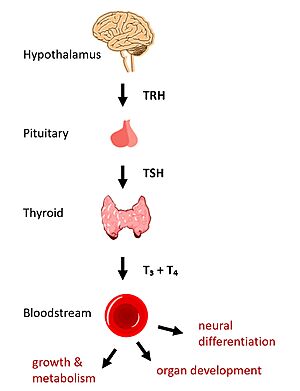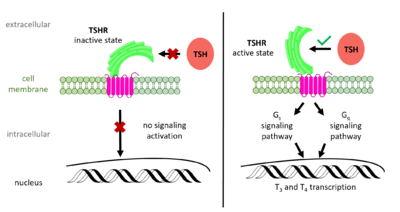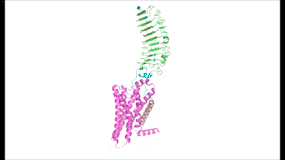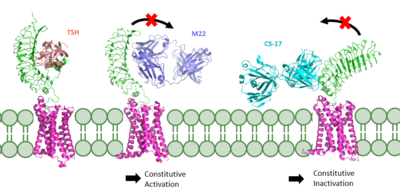Sandbox Reserved 1774
From Proteopedia
(Difference between revisions)
| Line 18: | Line 18: | ||
=== Importance of Hinge Region to Signaling Activation === | === Importance of Hinge Region to Signaling Activation === | ||
| - | [[Image:TSH Signaling.png|right|thumb|Figure 2: (Left) In the downright, inactive state, TSH cannot bind and no signaling activation occurs. (Right) In the upright, active state, binding of TSH leads to GPCR signaling activation and production of T3 and T4 hormones.]] | + | [[Image:TSH Signaling.png|right|400 px|thumb|Figure 2: (Left) In the downright, inactive state, TSH cannot bind and no signaling activation occurs. (Right) In the upright, active state, binding of TSH leads to GPCR signaling activation and production of T3 and T4 hormones.]] |
The TSHR hinges between two states: <scene name='95/952702/Overlay/2'>active and inactive</scene>. When the extracellular domain is hinged down, the receptor is inactive and no signaling activation occurs. When the extracellular domain raises into the upright position, the hinge region deforms and interacts with the extracellular loops to cause a conformation change in the TM domain and corresponding G-protein activation <ref name="Bruser">Bruser A, Schulz A, Rothemund S, et al. The Activation Mechanism of Glycoprotein Hormone Receptors with Implications in the Cause and Therapy of Endocrine Diseases. J Biol Chem. 2016;291(2):508-520. [https://doi.org/10.1074/jbc.M115.701102 DOI:10.1074/jbc.M115.701102]</ref>. While transition between the active and inactive states occurs spontaneously, favoring of one state over the other is influence by hinge interactions and ligand binding <ref name="Faust">PMID:35940205</ref>. When stabilized in the upright conformation, the activated GPCR signaling pathway results in transcription of thyroid hormones T3 and T4 (Fig. __) <ref name="Chu" />. | The TSHR hinges between two states: <scene name='95/952702/Overlay/2'>active and inactive</scene>. When the extracellular domain is hinged down, the receptor is inactive and no signaling activation occurs. When the extracellular domain raises into the upright position, the hinge region deforms and interacts with the extracellular loops to cause a conformation change in the TM domain and corresponding G-protein activation <ref name="Bruser">Bruser A, Schulz A, Rothemund S, et al. The Activation Mechanism of Glycoprotein Hormone Receptors with Implications in the Cause and Therapy of Endocrine Diseases. J Biol Chem. 2016;291(2):508-520. [https://doi.org/10.1074/jbc.M115.701102 DOI:10.1074/jbc.M115.701102]</ref>. While transition between the active and inactive states occurs spontaneously, favoring of one state over the other is influence by hinge interactions and ligand binding <ref name="Faust">PMID:35940205</ref>. When stabilized in the upright conformation, the activated GPCR signaling pathway results in transcription of thyroid hormones T3 and T4 (Fig. __) <ref name="Chu" />. | ||
| - | |||
| - | [[Image:TSHR MorphBetterAngle GIF.gif]] | ||
Modulation of TSHR signaling would not be possible without the hinge region, which accommodates up-and-down rotation of the extracellular domain as a rigid body about an imaginary 55 degree axis <ref name="Faust" />. During this transition, the hinge region undergoes <scene name='95/952702/P10_movement/4'>slinky-like deformation</scene> and is displaced approximately 5 Angstroms upward as it uncoils <ref name="Faust" />. The hinge region pulls on the linked transmembrane helices as it stretches, shifting <scene name='95/952702/Helix7_movement/2'>TM helix 7</scene> approximately 4 Angstroms inward and leading to G-protein signaling activation <ref name="Faust" />, <ref name="Bruser" />. | Modulation of TSHR signaling would not be possible without the hinge region, which accommodates up-and-down rotation of the extracellular domain as a rigid body about an imaginary 55 degree axis <ref name="Faust" />. During this transition, the hinge region undergoes <scene name='95/952702/P10_movement/4'>slinky-like deformation</scene> and is displaced approximately 5 Angstroms upward as it uncoils <ref name="Faust" />. The hinge region pulls on the linked transmembrane helices as it stretches, shifting <scene name='95/952702/Helix7_movement/2'>TM helix 7</scene> approximately 4 Angstroms inward and leading to G-protein signaling activation <ref name="Faust" />, <ref name="Bruser" />. | ||
| + | |||
| + | [[Image:TSHR MorphBetterAngle GIF.gif]] | ||
=== Stabilizing Interactions in the Hinge === | === Stabilizing Interactions in the Hinge === | ||
Revision as of 03:36, 14 April 2023
| This Sandbox is Reserved from February 27 through August 31, 2023 for use in the course CH462 Biochemistry II taught by R. Jeremy Johnson at the Butler University, Indianapolis, USA. This reservation includes Sandbox Reserved 1765 through Sandbox Reserved 1795. |
To get started:
More help: Help:Editing |
| |||||||||||




